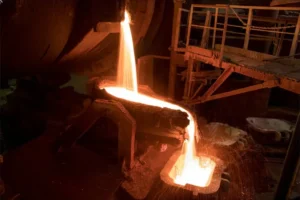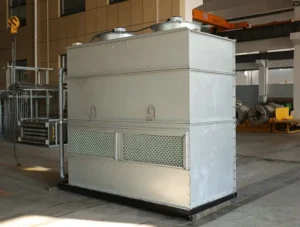การเปรียบเทียบทางเทคนิคอย่างลึกซึ้งของทอพอโลยีแหล่งจ่ายไฟหลักสองตัว, analyzing their differences in power factor, startup characteristics, impact on the power grid, and maintenance complexity.
ความแตกต่างหลักโดยสรุป
| คุณสมบัติ | Series Resonant Converter (SRC) | Parallel Resonant Converter (PRC) |
| Topology | The resonant tank is in series with the load. | The resonant tank (or part of it) is in parallel with the load. |
| เพาเวอร์แฟกเตอร์ | Highly sensitive to load; power factor may drop at light loads. | Insensitive to load variations; can maintain a high power factor even at light loads. |
| Startup Characteristics | Controllable inrush current; acts like a current source. | Prone to large inrush currents at startup; acts like a voltage source. |
| Grid Impact | Input current waveform is closer to a sine wave; lower harmonic content. | Relatively higher harmonic content in the input current. |
| การซ่อมบำรุง & Stress | Insensitive to short circuits but high voltage stress during open-circuit conditions. | Insensitive to open circuits but high current stress during short-circuit conditions. |
| Ideal Applications | Scenarios with a narrow load range and a need for robust short-circuit protection. | Scenarios with a wide load range and a need for stable output voltage. |
เพาเวอร์แฟกเตอร์: The Wide-Load Advantage of Parallel Resonance
The power factor is a critical metric for a power supply’s energy efficiency. At resonance, the resonant networks of both topologies behave purely resistively, theoretically allowing them to achieve a unity power factor. อย่างไรก็ตาม, in real-world operation, changes in load and frequency disrupt this ideal state.
- Series Resonant Converter (SRC): Its resonant tank is in series with the load, meaning the load impedance directly affects the quality factor (Q-factor) of the resonant circuit. As the load decreases, the Q-factor drops, making the resonance less “sharp.” This increases the phase difference between the input voltage and current, causing the power factor to decline. To regulate the output over a wide load range, an SRC often requires a wide switching frequency range, which increases the likelihood of operating at non-resonant frequencies and further degrading the power factor.
- Parallel Resonant Converter (PRC): The load is parallel to the resonant capacitor, resulting in a relatively stable output voltage. Load variations have a much smaller impact on the resonant tank’s Q-factor. เพราะเหตุนี้, a PRC can maintain a high power factor across a very wide range of loads. This makes the PRC perform exceptionally well in applications with significant load changes, such as battery charging or LED driving.
บทสรุป: For applications requiring a high power factor across a wide load range, ที่ Parallel Resonant Converter holds a distinct advantage.
Startup Characteristics: ที่ “Gentle” Start of Series Resonance
The behavior of a power supply at startup, particularly the magnitude of the inrush current, is crucial for system safety.
- Series Resonant Converter (SRC): The SRC’s resonant tank functions as a band-pass filter, and its output characteristic is similar to a current source. This means that even in a short-circuit scenario, the current is limited by the impedance of the resonant tank. During startup, ก “soft-start” can be implemented by beginning at a switching frequency well above the resonant frequency and gradually decreasing it. This frequency sweep method effectively suppresses inrush current, enabling a smooth and controlled startup.
- Parallel Resonant Converter (PRC): The output characteristic of a PRC is more like a voltage source. With the resonant capacitor connected directly across the output, it creates a large inrush current at startup as it charges the output capacitors. While soft-start strategies can also be employed, the topology is inherently less effective at limiting startup current compared to an SRC.
บทสรุป: For applications with strict limits on inrush current that require a smooth startup, ที่ Series Resonant Converter is the safer choice.
Impact on the Power Grid: ที่ “Green” Performance of Series Resonance
With increasing demands for power quality, the harmonic distortion and electromagnetic interference (EMI) generated by power supplies have become critical considerations.
- Series Resonant Converter (SRC): Due to its current-source nature and the series resonant inductor, the input current waveform has its high-frequency components effectively suppressed after rectification and filtering. The resulting waveform is closer to a sine wave. This leads to lower harmonic content, less pollution to the power grid, and simplifies the design of the EMI filter.
- Parallel Resonant Converter (PRC): The input current of a PRC is often discontinuous and has greater waveform distortion, containing more high-order harmonic components. This not only increases interference with the power grid but also necessitates the design of more complex and expensive EMI filters to meet electromagnetic compatibility (อีเอ็มซี) standards.
บทสรุป: In applications with stringent requirements for low harmonic distortion and EMI, ที่ Series Resonant Converter offers a “greener” ผลงาน.
Maintenance Complexity and Component Stress
From a long-term operational and maintenance perspective, the two topologies exhibit different component stresses and potential failure modes.
- Series Resonant Converter (SRC):
- ข้อได้เปรียบ: It has inherent protection against output short circuits because the resonant tank limits the maximum current. This reduces the risk of damage to switching components from short-circuit events.
- ข้อเสีย: During open-circuit or light-load conditions, the voltage across the resonant tank can become extremely high (as the voltage gain increases with the Q-factor). This places immense voltage stress on the resonant capacitors and switching devices, potentially leading to component failure. ดังนั้น, reliable over-voltage protection circuits are essential.
- Parallel Resonant Converter (PRC):
- ข้อได้เปรียบ: It is insensitive to open-circuit conditions. Even with no load, the output voltage is clamped at a certain level, keeping component voltage stress under control.
- ข้อเสีย: During an output short circuit, the resonant capacitor is directly shorted by the load. The resonant tank then presents a low impedance, causing a sharp increase in the current flowing through the resonant inductor and switching devices, which can easily lead to overcurrent damage. ดังนั้น, fast and reliable over-current protection is required.
การซ่อมบำรุง ข้อควรพิจารณา:
- Troubleshooting: For an SRC, focus should be on overvoltage damage caused by open-circuit or light-load conditions. For a PRC, the primary focus should be on overcurrent damage caused by short-circuit or overload events.
- Component Selection: The switching devices in an SRC need a higher voltage rating, while those in a PRC require a higher current rating and faster over-current protection. In a PRC, significant circulating energy exists within the resonant tank at no-load or light-load, placing continuous stress on the resonant components and affecting their lifespan.
บทสรุป: The two topologies have different maintenance priorities. ที่ Series Resonant Converter is better suited for applications with a high risk of short circuits, while the Parallel Resonant Converter is a better fit for applications where open-circuit or frequent load changes are expected.
How to Choose Your Application
- Choose a Series Resonant Converter (SRC) if your application involves:
- A relatively stable load with a narrow operating range.
- Extremely strict requirements for low startup inrush current.
- Demanding standards for low grid harmonics and EMI.
- A high probability of output short circuits, such as in motor drives or arc welding applications.
- Choose a Parallel Resonant Converter (PRC) if your application involves:
- A very wide load range with frequent changes from light to full load, such as in server power supplies or battery chargers.
- The need for a stable output voltage and high power factor across a wide load range.
- Startup inrush current not being the primary design constraint.
- The possibility of output open-circuit conditions.
สรุป, neither the series nor the parallel resonant converter is definitively superior; each has its own strengths. A thorough understanding of their technical characteristics under different operating conditions is the key to making the right design choice and ensuring the long-term stability and reliability of your power system.







